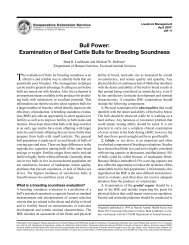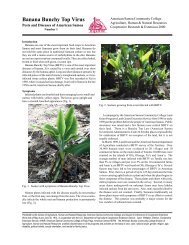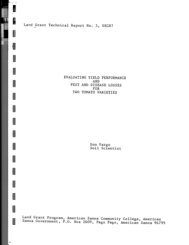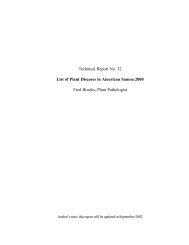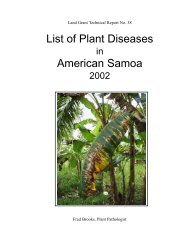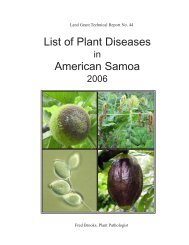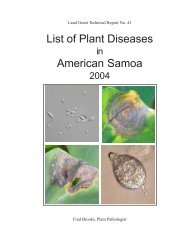Create successful ePaper yourself
Turn your PDF publications into a flip-book with our unique Google optimized e-Paper software.
.<br />
...~<br />
I<br />
I<br />
,<br />
I.<br />
land ~rant Technical Report <strong>No</strong>. <strong>11.</strong> OCT 89<br />
I<br />
INFORMATION ON SOME TROPICAL AND SUBTROPICAL<br />
FRUIT TREES<br />
AT THE<br />
LAND GRANT AGRICULTURAL EXPERIMENT STATION<br />
MALAEIMI, AMERICAN SAMOA<br />
Don Vargo<br />
Soil Specialist<br />
.<br />
I<br />
..<br />
. ị<br />
land Grant Program, American Samoa Community College,<br />
P.O. Box 2609, Pago Pago, American Samoa 96799.<br />
American Samoa Government,
I<br />
I<br />
I<br />
I<br />
ABSTRACT<br />
In 1985, twenty-five species of tropical<br />
and subtropical fruit and nut trees were<br />
introduced to Tutuila, American Samoa.<br />
These trees were planted at six sites<br />
throughout the island, including one site<br />
at the Land Grant Agricultural Experiment<br />
Station at Malaeimi. What follows are<br />
brief descriptions of many of these tree<br />
species, taken from several sources, to aid<br />
people in learning something about the<br />
trees.<br />
I<br />
I<br />
I<br />
,<br />
.<br />
-I<br />
.
-<br />
Acerola Cherry. Maloiahia alabra. Family and genus named after Marcello Mal-<br />
; pighi (1628-1694) (Malpighiaceae). An evergreen to semideciduous shrub,<br />
,<br />
6~to 10 feet high and 4 to 6 feet wide. Leaves are shiny and ovate, 1 to<br />
3 inches long with smooth edges. The 1/2-inch diameter flowers are white<br />
to pink and appear toward the end of the dry season. The fruit is bright<br />
red, tinged yellow, cherry-like, obscurely 3-10bed with a sweet to tart<br />
flavor. Each fruit contains 3 triangular, ridged seeds. The fruit, high<br />
inrvitamin C, is usually too acidic to eat raw, but is excellent in jelly.<br />
The free grows well in clay or sandy soils, but is susceptible to rootknot<br />
nematodes.<br />
Caramqola, Star-fruit. Averrhoa carambola L. Wood-Sorrel Family (Oxalidaceae).<br />
Carambola, a Malaysidn tree, is cultivated for its fruit. It has many<br />
branches and ranges in height from about 20 to 30 feet. It has .dense<br />
evergreen foliage, each leaf half a foot long, consisting of 3 to 11 oval,<br />
smooth, paired (or nearly so) leaflets, with an extra leaflet at the tip.<br />
Small clusters of tiny red, dark pink to white flowers appear on bare<br />
branches or at leaf bases. Fruit is sometimes borne on three-year-old<br />
trees. The fruit is waxy, greenish-yellow to orange, oblong, 2 to 5 inches<br />
long, with five length-wise ridges. A thin, fragrant skin covers a watery,<br />
acid, pleasant-tasting pulp. Two varieties are raised: one is strongly<br />
acid and best to 'eat when preserved; the other is sweet and good when raw.<br />
Durian. QyriQ zibethinus L. Murr. Bombax Family (Bombacaceae). A large-sized<br />
tree of 100 ft or more, perhaps a native of Borneo, is famous for its<br />
fruit. Twigs and underside of the short-stemmed, shiny, dark green leaves<br />
are covered with silvery or coppery scales. Leaves are oblong, 3 to 7<br />
inches long, and fragrant when crushed. White flowers, 2 inches long, are<br />
clustered on the branches, have a scaly, five-lobed calyx, five petals,<br />
and a staminal column bearing many unpleasant smelling stamens. The<br />
greenish-yellow, ovoid, five-celled fruit is 6 to 12 inches long and 5 to<br />
6 inches in diameter, with a thick spiny rind enclosing a creamy,<br />
delicious, but unpleasant-smelling (rotten onion!) pulp. The large yellow<br />
seeds are sometimes cooked and eaten.<br />
Gramichama, Grumixama. EuQeniadombe~i, Skeels; synonyms, I. brasiliensis, Lam.,<br />
Stenoca1vx brasiliensis, Berg. Myrtle Family (Myrtaceae). A native of<br />
Brazil, this slow growing tree may reach 10 to 20 feet high and 6 to 8 feet<br />
wide. Its leaves are elliptical, glossy, deep green, and 2 to 3 inches<br />
long. The small white flowers produce a purple-black fruit about 3/4 inch<br />
in diameter. The thin skin covers a soft white flesh with a sweet, mild<br />
acid flavor. The seeds are round or hemispherical, with us-ual1y lor 2<br />
per fruit. The tree does best when there is plenty of moisture.<br />
Grapefruit, Pomelo. Citrus paradisi Macf. Rue Family (Rutaceae). The<br />
grapefruit, a native of the West Indies, is much like the pummelo, but the<br />
fruit is smaller, juicier, and clustered, with pulp commonly pale green<br />
to yellow. The_Marsh variety is seedless, with some forms having a pink<br />
pulp. Grapefruit is said to excite the flow of the salivary and gastric<br />
juices and thus to stimulate the appetite.<br />
.<br />
t<br />
:.
-I<br />
I<br />
I<br />
1<br />
JacKfruit, Jak-Fruit, Jaca. Artocargus integra (Thunb.) Merr. (Moraceae). A<br />
large tree with dark green leaves about 6 inches long. The fruit are<br />
borne during the rainy season. They are oval to oblong with a rough green<br />
rind and may weigh up to 40 pounds. The pulp is eaten raw or cooked and<br />
has a sweet to tart flavor. Seeds are enclosed in a slippery, juicy<br />
covering, and may be roasted or boiled. They taste like chestnuts. The<br />
Jackfruit is a close relative to the breadfruit, A. communis.<br />
Lemon, Lemf. Citrus liffiQn (L.) Burm.f.; synonym, ~ limonia Osbeck. Rue Family<br />
(Rutaceae). The lemon is a small tree from Southeast Asia. The leaves<br />
are 2 to 4 inches long, edges scalloped, their stems very narrow-margined;<br />
.thorns large; fruit oval, 3 to 5 inches long, tip pointed, skin more or<br />
less rough, pulp juicy, sour, with 8 to 10 segments. .<br />
Lime. Citrus aurantiifolia (Christmann) Swingle. RueFam~Rutaceae). The<br />
lime is somewhat like the lemon, originating in India or Southeast Asia,<br />
but the leaves are smaller, the fruits smaller, more nearly globose, and<br />
the skin thinner, smoother, greenish yellow. Many varieties are known,<br />
including the Kusaie, Rangpur and Tahiti.<br />
longan, Dragons Eye. Euphoria longan (lour.) Steud. Soapberry Family<br />
(Sapindaceae). The longan, an evergreen 25 to 40 feet high and equally<br />
wide, is from China. The twigs are brownish woolly. The leaves are<br />
compound, 8 to 10 inches long and have 6 to 12 alternate or nearly<br />
opposite, oblong, leathery, blunt or pointed leaflets 2 to 6 inches long.<br />
Panicles of small, yellowish-white, brownish-woolly flowers, each with five<br />
sepals and five petals, are borne at branch tips and leaf basis. The ripe<br />
fruit are yellow to brown, globose, 1 inch in diameter, and hang in grapelike<br />
clusters. Its crust is thin, nearly smooth, marked with a fine<br />
honeycomb pattern covering white, juicy, edible pulp, which is separate<br />
from the single, shiny, dark brown seed. The pulp tastes like that of the<br />
litchi but is less flavorful. It is commonly eaten raw. In China, the<br />
pulp is also canned, or the fruit is dried, like that of the litchi.<br />
I<br />
I<br />
Loquat. Eriobotrva .iaoonica (Thunb.) Lindl. Rose Family (Rosaceae). The loquat<br />
is a low, evergreen, drought-resistant tree 10 to 20 feet high, which is<br />
used both decoratively and as a fruit tree in central China, its home, and<br />
in many warm countries. The fruit is often stung by the Mediterranean<br />
fruit fly. Best and largest fruit is borne on grafted trees between<br />
altitudes of 3000 and 5000 feet. Near the ends of branches are long-oval,<br />
thick, tooth leaves,S to 10 inches long, shiny above, rusty-woolly<br />
beneath, on short petioles. White, fragrant, five-petaled flowers, about<br />
1/2 inch in diameter, develop in the fall in rusty clusters at branch<br />
ends. The yellow, downy, globose fruit, which is about 1.5 inches long,<br />
with a pleasant acid-flavored, white or yellow flesh enclosing a few large<br />
seeds, ripens in clusters. It is eaten raw or cooked.<br />
Litchi. Lychee, Leechee. Litchichinensis Sonn. Soapberry Family (Sapindaceae).<br />
The litchi, a thick-foliaged, broad-crowned fruit tree from Southern China,<br />
grows slowly to a height of about 30 feet. The leaves are compound and<br />
have 2 to 4 pairs of shiny, oblong, drooping leaflets, 3 to 7 inches long,<br />
lighter below, very pale green when young. They are less distinct and<br />
2
I<br />
fewer-veined than those of the longan. The flowers have five sepals and<br />
no petals. A good tree bears 200 or more pounds of fruit during the<br />
summer, some beginning when 5 years old, some not in 20 years. The<br />
perishable fresh fruit, highly prized for its delicious flavor, is a good<br />
source of ascorbic acid and phosphorus. The dried fruit, called "litchi<br />
nuts", is shipped long distances, being prepared in China by drying in the<br />
sun. Much is also canned in syrup, when, like the fresh fruit, the pulp<br />
isr white and has a grape-like consistency. The dried fruit is quite<br />
diff~rent,<br />
a raisin.<br />
having reddish-brown, sticky, shrunken, sweeter pulp, much like<br />
The large brown seed enclosed in the pulp of each fruit is<br />
short-lived, dying 4 or 5 days after picking. The fruit is usually<br />
preferred to the longan, is larger, and has a rougher red shell. Litchi<br />
trees need considerable moisture. They are injured by several insect<br />
pests.<br />
Orange. sweet. Citrus sinensis (L '. Osbeck; synonym, h aurantium var. sinensis<br />
L. Rue Family (Rutaceae). :The orange is ~. medium-sized tree from China.<br />
The leaves are 3 to 4 inches long. more or less scalloped, their stems<br />
narrow-margined; thorns few to none; fruit globose, to 3 inches in<br />
diameter, skin orange, smooth and tight, pulp juicy, sweet, with 10 to 13<br />
segments, the core solid.<br />
.<br />
Pummelo. ShaddocK. Citrus Qrandis (L.) Osbeck; synonym, h maxima (Burm. Merr.<br />
Rue Family (Rutaceae). The pummelo, a native of Malaysia and Polynesia,<br />
is a tree 15 to 30 feet high. The leaves are 3 to 8 inches long, scallopedged,<br />
their stems broadly winged, with slender or no spines. The fruits<br />
are solitary, globose to pear-shaped, about 6 inches in diameter, with<br />
smooth, pale yellow skin, and comparatively dry, yellow or reddish, sour<br />
pulp in 11 to 14 segments. The pulp is used raw in salads and cooked in<br />
jam with the rind.<br />
Rambutan, Rambotang, Rambustan. NeDhe1ium 1aDDaceum L. (Sapindaceae). A native<br />
of Malaysia, this large, speading tree may grow 35 to 40 feet high. Its<br />
compound leaves are composed of 5 to 7 pairs of shiny, dark green elliptic<br />
leaflets about 4 inches long. The small green flower (a calyx with no<br />
petals) has fine hairs and .is divided into 4 to 6 lobes. A single tree<br />
usually contains both male and female flowers. The fruit is red or orangeyellow,<br />
about the size and shape of a hen's egg, borne at the tips of<br />
branches in a bunch of 10 to 20. It has 1/2 inch long, soft, fleshy<br />
spines, resembling burrs. A white, juicy, sweet pulp surrounds a large<br />
seed. In the hot, humid tropics, the tree usually fruits twice a year.<br />
The bark is used as a folk medi.cine.<br />
Rollinia. Rollinia deliciosa Safford. Custard-Apple Family (Annonaceae).<br />
Rollinia is a medium-size Brazilian tree or shrub. Leaves are elliptic,<br />
acuminate, 8 to 11 inches long. The flowers bear wings on the three outer<br />
petals. The fruit are much like that of the sugar-apple, being roundish<br />
oblate,_3 to 5 inches in diameter, cream-yellow with a cream-colored flesh<br />
that is-juicy and sweet. The tree is noted for its rapid growth.<br />
Sapodilla, Chico, Chicle tree. Manilkara zapota (L.) van Royen; synonyms, Achras<br />
zapota L., Sapota achras Mill. Sapodilla Family (Sapotaceae). A smooth,<br />
3
1<br />
I<br />
variable, evergreen tree ranging in height from 15 to 60 feet, from Central<br />
America, where it forms forests on lime soil, is the main source of chicle<br />
for chewing gum. To obtain the gum, trees are tapped only once in two or<br />
three years. In a few hours a tree yields about 60 quarts of white latex<br />
containing about 25 to 50% chicle, which undergoes many processes to<br />
prepare it for the final product. The shiny oblong leaves, about 2 to 5<br />
inches long and 1 to 2 inches wide, are clustered at rusty ends of<br />
b~anches, and among them in season and solitary on long stems at leaf axils<br />
appear white, green, or brown six-parted flowers, about 1/3 inch long, that<br />
are fragrant at night. The fruit is brown, globose to ovoid, 1 to 2 or<br />
more inches long, and has a thin skin covering reddish or brownish, soft,<br />
sweet, edible pulp with 1 to 12 black shiny seeds. It is a favorite fruit<br />
in tropical America, and the tree is cultivated for the fruit there and<br />
in many other tropical regions. The wood is hard, fine, red, and useful<br />
for many articles. ..:"'~~--)\<br />
.<br />
I-.<br />
J<br />
Sapote, black. OiOSDyrOS ebenaster Retz. Ebony Family (Ebenaceae). A Mexican<br />
and West Indian tree which grows to about 45 feet high. It has smooth,<br />
blunt leaves, 4 to 8 inches long, and a green to black, smooth, globose<br />
fruit about 4 inches in diameter, which is insipid to eat raw but is good<br />
cooked with lemon or preserved. Green fruit is said to have poisonous<br />
properties and has been used to aid in narcotizing fish.<br />
Sapote, white. Casimiroa edulis llave and lex. Rue Family (Rutaceae). A broadcrowned<br />
tree from Mexico and Central America has palmately divided leaves<br />
5 to 8 inches in diameter, with 3 to 7 oval, leathery, short-stalked<br />
leaflets. Flowers are small, five-parted, greenish or whitish, in short<br />
clusters at branch tips and leaf axils. The rounded, shallowly five-lobed,<br />
somewhat applelike fruit is ~bout 3 inches in diameter and has a thin green<br />
or yellow skin covering soft, whitish, juicy, edible, sweetish pulp, which<br />
surrounds 3 to 5 seeds. In Mexico the bark, leaves, and seeds, which<br />
contain a glucoside, are used medicinally to induce sleep. The wood is<br />
white, soft, and not durable.<br />
Soursop. Annona muricata L. Custard-Apple Family (Annonaceae). The soursop<br />
is a small evergreen tree from Peru and Ecuador. Its leaves, smooth and<br />
shiny-green on top, for a time have a reddish down underneath. The flowers<br />
ordinarily appear singly or sometimes opposite the leaves, are yellowish<br />
and about 2 inches in diameter, have 6 thick petals and a peculiar odor.<br />
The shiny, dark green, irregularly heart-shaped, softly spiny fruits 6 to<br />
8 inches long, weigh 1 to 6 pounds. The pulp is like white cotton<br />
saturated with a sour juice, from which a pleasing, refreshing drink are<br />
made in parts of tropical America. The fruits are also eaten by livestock.<br />
Inch-long, black seeds are embedded in the pulp. Both leaves and fruit<br />
have a peculiar odor.<br />
I<br />
Sugar Apple, Sweetsop. Annona sQuamosa L. Custard-Apple Family (Annonaceae).<br />
A semi-deciduous tree from Peru and Ecuador, 15 to 20 feet tall with<br />
narrow, pale green, lanceolate leaves 2 to 4 inches long. Flowers appear<br />
singly or in clusters of 2 to 4, are greenish yellow, 1 inch long with<br />
the 3 outer pedals oblong, thick, and rounded at the tips. Fruits are<br />
I 4
ound to conical, 2 to 3 inches in diameter, yellowish green, and covered<br />
with large, prominent knobs. The white pulp is sweet and slightly acidic<br />
in sections that fall apart. It contains some brown seeds the size of<br />
small beans. Both leaves and fruits have insecticidal properties.<br />
I-.<br />
Surinam Cherry. Eugenia uniflora L. Myrtle, Family (Myrtaceae). Eugenia<br />
includes about 900 species of trees and shrubs distributed throughout the<br />
t~opics. The Surinam Cherry, from Brazil, is a large evergreen shrub or<br />
small tree 10 to 20 feet tall and 6 to 8 feet wide. The glossy green<br />
leaves are 1 to 2 inches long, ovate; flowers white to cream-colored,<br />
single or few together, with four round petals about 1/3 inches in dia-<br />
'meter; fruits deeply eight-ribbed, red to black with a like colored flesh,<br />
spicy, acid, with 1 or 2 large seeds. Good eaten fresh or in jellies and<br />
jams. The tree makes an excellent hedge.<br />
Tamarind, Wi'awa'awa. Tamarindus indica L. Pea Family (Leguminosae); Senna<br />
Subfamily (Caesalpinioideae). The tamarind is a slow-growing tree,<br />
probably a native of tropical Africa and Asia, where it is a favorite fruit<br />
and shade tree. It can reach a height of 80 feet. It has open, spreading<br />
branches and graceful, feathery foliage, each leaf having 10 to 20 pairs<br />
of 1/2 inch long leaflets. The flowers are small, red and yellow, and have<br />
3 petals, which' equal the four-lobed narrow calyx. The pod is velvety,<br />
reddish brown, thick, 2 to 8 inches long, and its brittle shell never opens<br />
voluntarily. It encloses a few seeds embedded in a thick, sticky, brown<br />
pulp, from which a pleasant-tasting syrup is made for use in drinks,<br />
curries, and chutneys. This pulp, which contains much sugar and tartaric<br />
acid, has cooling and laxative properties and is also used as a gargle.<br />
In India, the leaves and the bark are used as medicines.<br />
I<br />
I<br />
I<br />
I<br />
I<br />
Wampi. Clausena lansium (Lour.) Skeels; synonym, ~ ~ (Blco.) Oliver. Rue<br />
Family (Rutaceae). The wampi is a shrub or small tree from southern China.<br />
The leaves have 5 to 9 alternate, oval, shiny, resin-scented leaflets, each<br />
about 2 inches long. It bears many small, white, five-parted flowers in<br />
clusters at branch tips. The fruits are globose berries with 5 sections,<br />
1 inch in diameter, hairy, yellowish brown, with white pulp, tasting like<br />
gooseberries or grapes. They are eaten raw, in jam, or made into a drink,<br />
and in Thailand are considered one of the finest of fruits.<br />
I 5<br />
1 ~~<br />
t-1
I<br />
REFERENCES<br />
I<br />
,<br />
Ị<br />
I<br />
I<br />
I<br />
.<br />
I 6<br />
I



